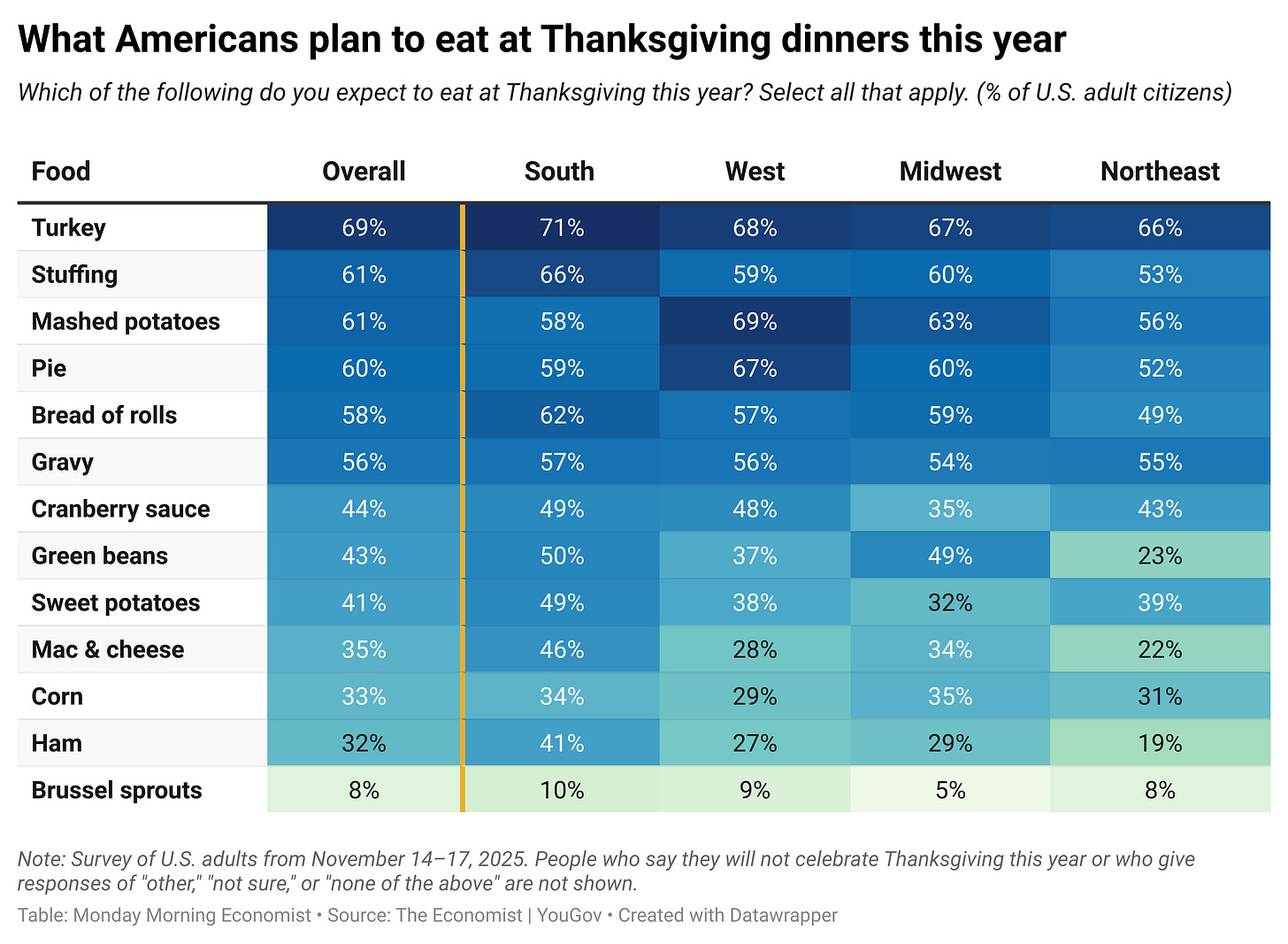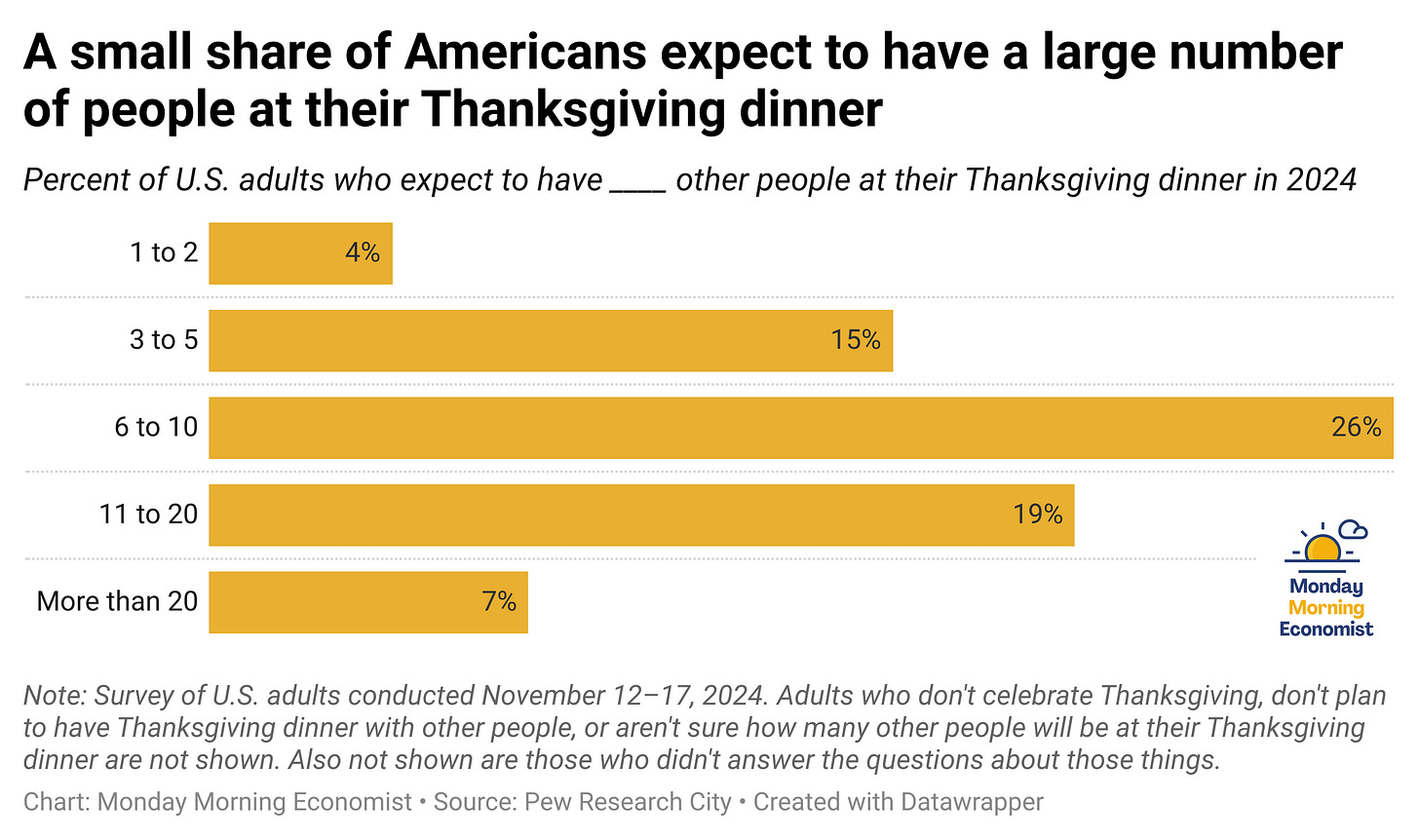The Thanksgiving Meal That Plans Itself
Why Thanksgiving dinner looks the same across the country, even though no one is in charge of designing it.
You’re reading Monday Morning Economist, a free weekly newsletter that explores the economics behind pop culture and current events. Each issue reaches thousands of readers who want to understand the world a little differently. If you enjoy this post, you can support the newsletter by sharing it or by becoming a paid subscriber to help it grow:

The turkey goes in the oven. Someone starts peeling potatoes. Someone else debates whether cranberry sauce counts as homemade if it still has the can lines. Even if you’re not cooking at home, maybe you’re picking up a prepared meal, eating at a restaurant, or heading to a community center, you still know exactly what will be on the table.
Before you ever sit down to eat, the menu is already in your head: turkey, mashed potatoes, stuffing, green bean casserole. Maybe sweet potato casserole. Maybe mac and cheese. And maybe an uncle who brings a side dish no one requested.
It’s remarkable how predictable it all is. Millions of people will eat almost the same meal on the same day. Inside individual households, there’s plenty of planning: grocery lists, group texts, oven schedules.
But nationally? Almost none. There’s no Thanksgiving committee. No federal memo announcing the official menu. Yet somehow, the country still manages to coordinate millions of turkeys, mountains of potatoes, shelves full of stuffing mix, and a once-a-year spike in canned pumpkin.
It feels orchestrated. But no one is in charge.
So What’s Going On Here?
If you looked at Thanksgiving from the outside, you might think someone is directing the whole thing. It all feels coordinated. But economists have a term for this kind of pattern that emerges without anyone being in charge: spontaneous order.
Spontaneous order happens when lots of people make their own decisions, and the result looks organized even though no one planned it. Families choose turkey because that’s what their families have always done. Grocery stores stock it because people buy it. Farmers raise millions of birds because grocery stores place orders months in advance.
There’s no national committee assigning dishes. No coordinating body deciding how many turkeys each state gets. No Thanksgiving Czar managing supply chains.
Instead, everyone holds a tiny piece of information, reacts to the incentives in front of them, and somehow the pieces fit together. Farmers, distributors, supermarkets, restaurants, and households all make their own choices, and the outcome is a meal so predictable it feels designed.
Hayek had a line for this: spontaneous orders are “the result of human action, but not of human design.” It’s a useful way to understand why Thanksgiving works so well, and a good starting point for looking at his other examples.
What Hayek Would See in Your Kitchen
Friedrich Hayek spent much of his career studying how societies organize themselves without central direction. He was interested in how systems like language and law seemed to emerge naturally from human behavior rather than from committees or planners. His work is often used as the foundational justification for market economies, where supporters argue that decentralized decisions usually lead to a more efficient allocation of resources than any design could achieve.
Hayek’s examples were intentionally broad. No one invented English, yet it functions as a stable communication system. No one wrote a master plan for common law, yet legal norms evolved through repeated decisions. And no single person can ever hold all the information needed to run an economy, which is why prices and local knowledge play such important roles in coordinating activity.
So, what would Hayek think of the Thanksgiving holidays? The holiday meal wasn’t designed by any authority. The menu emerged over time through tradition and repetition. Families choose certain dishes because that’s what they’ve always served. Stores stock them because families expect them. Producers anticipate demand based on past behavior. It’s the same process Hayek described: countless decisions made independently, producing a pattern that feels organized even though no one planned it.
Final Thoughts
Turkey isn’t the only tradition we return to each year. Thanksgiving is also built around gratitude, and it’s worth extending that beyond the people sitting at the table. A book I enjoy (Thanks a Thousand) follows the author as he tries to thank everyone responsible for his morning cup of coffee, from the barista to the farmers who grew the beans to the engineer who designed the cardboard sleeve that keeps the cup from burning his hand. His point is simple: even the most ordinary things depend on an enormous network of people we rarely see.
Thanksgiving works the same way. The meal on the table didn’t come from a single plan, but from the work of countless people whose efforts fit together. We should be thankful for the family and friends who cooked the meal, but also for the grocery store employees who stocked the shelves, the delivery drivers who kept trucks moving, the workers in food processing plants, and the farmers who raised the crops and livestock that make the holiday possible.
And while we’re giving thanks, a special nod goes to Dorcas Reilly, who invented my favorite Thanksgiving dish: the green bean casserole. Her recipe started as a simple idea in a test kitchen. Today, it’s part of a tradition shared by millions, woven into a holiday meal that no one designed but almost everyone recognizes.
If this newsletter added something to your Thanksgiving table, consider sharing it with a friend or colleague. It helps more people join the conversation each week.
About one-quarter of Americans say Thanksgiving is their favorite day of the year [YouGov]
A table of classic dishes for 10 people will cost $55.18, down 5% from last year, but still higher than four years ago [American Farm Bureau]
Around nine-in-ten Americans (91%) celebrate Thanksgiving [Pew Research Center]
The average commercial turkey sold in grocery stores weighs just over 30 pounds, which means Americans consume nearly 1.4 billion pounds of turkey during the holiday [Business Insider]
There are some 2,500 turkey farms across the U.S. [National Turkey Federation]







Great post. I especially appreciate this one because I watched you work on it in Tampa, plus it is a neat topic. I will be having a Tomahawk Steak.